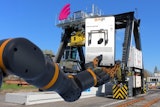Which business technologies will lead the way in 2014? Research firms, journalists, and bloggers are gearing up to share their thoughts on this question and offer their predictions over the few weeks. Immersed in today’s dynamic business technology environment and excited about what’s to come, we at LNS Research offer our early list of main focus areas you can expect experts to be discussing over the next few months.
1. Mobile
At this point in late 2013, reports suggest that mobile devices are outpacing PCs as the primary source for computing. Traditional business functions (and innovative new ones) are increasingly expected to be accompanied by a solution in the app store. In 2014, managing by walking around will continue to occur, only even more-so with a tablet or smartphone in hand.
Expect to see a diversity of predictions touching on further consumerization—and Bring Your Own Device (BYOD)—related issues. These will include supporting cloud-based, mobile application infrastructures, cybersecurity, compatibility, software-to-app migration, proximity sensing, and organizations’ abilities to match IT support capabilities with growing user needs.
2. Big Data & Analytics
In recent years, we’ve experienced an explosion of data. Reports say that the amount is doubling every few days. And with Internet/Intranet connectivity becoming more commonplace, new trajectories can be expected. Software vendors and in-house IT departments alike are working hard to develop simpler, faster solutions for harnessing this growing giant.
The challenge is certainly in a wrestling match with the opportunity right now and in 2014 we can expect that to shift into manufacturers' and other businesses' favor. Expect predictions around new techniques for uncovering consumer insights and manufacturing asset and production improvements, as well as a rise in cloud-based solutions for big data and analytics.
3. Cybersecurity
2013 was a tough year for cybersecurity. The NSA proved that information is not as secure from third-parties as many businesses assumed it was. And from corporate Twitter account breaches to confidential information getting into the wrong hands, we saw that hackers continue to be a very real threat.
As cloud, mobility, and connected devices make more headway in the business realm, expect to see predictions around the tradeoffs between accessibility, cost, and risk, as well as best practices for ongoing information security management and the need for ‘secure-by-design’ software and systems.
4. Cloud-Computing & SaaS
As servers continue to become virtual and move off premise, the contrasting total cost of ownership and maintenance requirements make the cloud a viable option for many businesses. It’s transformed the way companies and individuals communicate and collaborate. And distributed facilities, suppliers, and partners that were once disconnected can now easily sync in at the click of a button.
Virtualization is the first step to cloud-computing, and that’s been achieved in most industries. But keep an eye out for predictions about legacy-minded industries like manufacturing to catch up. In addition to other cybersecurity-related predictions, you may also see ones surrounding the continued rise of Software as a Service (SaaS) business models for manufacturing applications.
5. Social Business
The intuitiveness and prevalence of social media platforms have already improved the way businesses share information and collaborate internally, as well as the way customer interactions and data are treated. And in 2013, we’ve seen businesses that capitalize on social integration differentiate from close-but-laggard competitors.
In 2014 the social business will have a big year. Expect to hear about investments made around building better tools to serve customers at a faster rate and predicting market trends in the mounting sea of big social data. And look out for solutions that enable collaboration to increasingly mirror today’s widely adopted social media platforms, catalyzing a deeper presence of personal social media tools into everyday business activities.
6. Connected Devices
You can’t look through Twitter or LinkedIn’s top stories without seeing something about the Internet of Things (IoT) or Internet of Everything (IoE) these days. Connected devices are rapidly making their way into businesses (and homes), and everyone’s excited about it. The links between people, machines, and the environment are only becoming stronger, and the business world is poised to have even more data than it knows what to do with.
As everything and everyone becomes more connected, look out for predictions focusing on some of the implications with the IoE, specifically around managing workflows and contextualizing information. There will be foresights about the challenges with network bandwidth, security, and an overload of data, as well as discussions regarding the need for updating and even creating new standards.
7. Additive Manufacturing
3D printing is another buzzword that’s dramatically grown in popularity in 2013. Businesses (as well as some consumers) are identifying new ways to capitalize on its potential, and that trend seems to be only picking up speed. From simple tasks such as building tools on-site to more complex ones like rapidly developing prototypes, 3D printing is emerging as a driver for cost savings and efficiency across many industries.
For 2014, expect to see predictions about 3D printing becoming not just a more affordable business technology, but requisite for sustaining competitiveness in some industries. Printing has matured beyond prototyping into the actual production of high-tolerance mechanical parts. Advancements to the technology will continue to speed up new product introduction times, as the ability to leverage CAD/3D design software is enabling high levels of communication and collaboration between design and manufacturing.
8. Augmented Reality
The definitive lines between real and virtual worlds have been blurring for years and, at some levels, augmented reality has already succeeded in making them one. Whether over the medium of a smart device or emerging technology like Google Glass, augmented reality can simulate computer generated manipulations and supplementations to one’s surroundings in real-time.
Expect 2014 predictions to focus on the intelligence behind augmented reality and its transformation into a powerful business tool. With the relationship between mobile devices and augmented reality tightening, you can expect to see more and more solutions being rolled out.
9. Simulation/3D Visualization
Advancements to simulation and 3dV software have made it possible to prototype and test complex parts, components, or products in an entirely virtual environment. As a result, less resources are required to bring new and even better products to market. This, coupled with the rising use of simulated work instructions, is transforming manufacturing and engineering environments.
For 2014, expect predictions around simulation and 3dV software being a game changer for companies developing and producing highly complex products. With this technology, the traditional silos between engineering and manufacturing will continue to evolve into portals for quality improvements.
10. Software Platforms & Modular Apps
Despite the benefits of an integrated, harmonized enterprise IT architecture, many companies are still working with disconnected systems and data sources. Consequently, achieving the levels of communication and collaboration needed to compete today can be a resource-intensive undertaking.
Expect predictions around next-generation enterprise software platforms stacked with more functionality that make integration with other enterprise systems and data sources less costly. You can also expect to see predictions regarding more rollouts of modular apps instead of large monolithic systems and inter-dependent applications.
As these and other technologies rapidly accelerate in their respective developments and business applications, it’s clear we have plenty to follow and look forward to going into 2014 and beyond.























